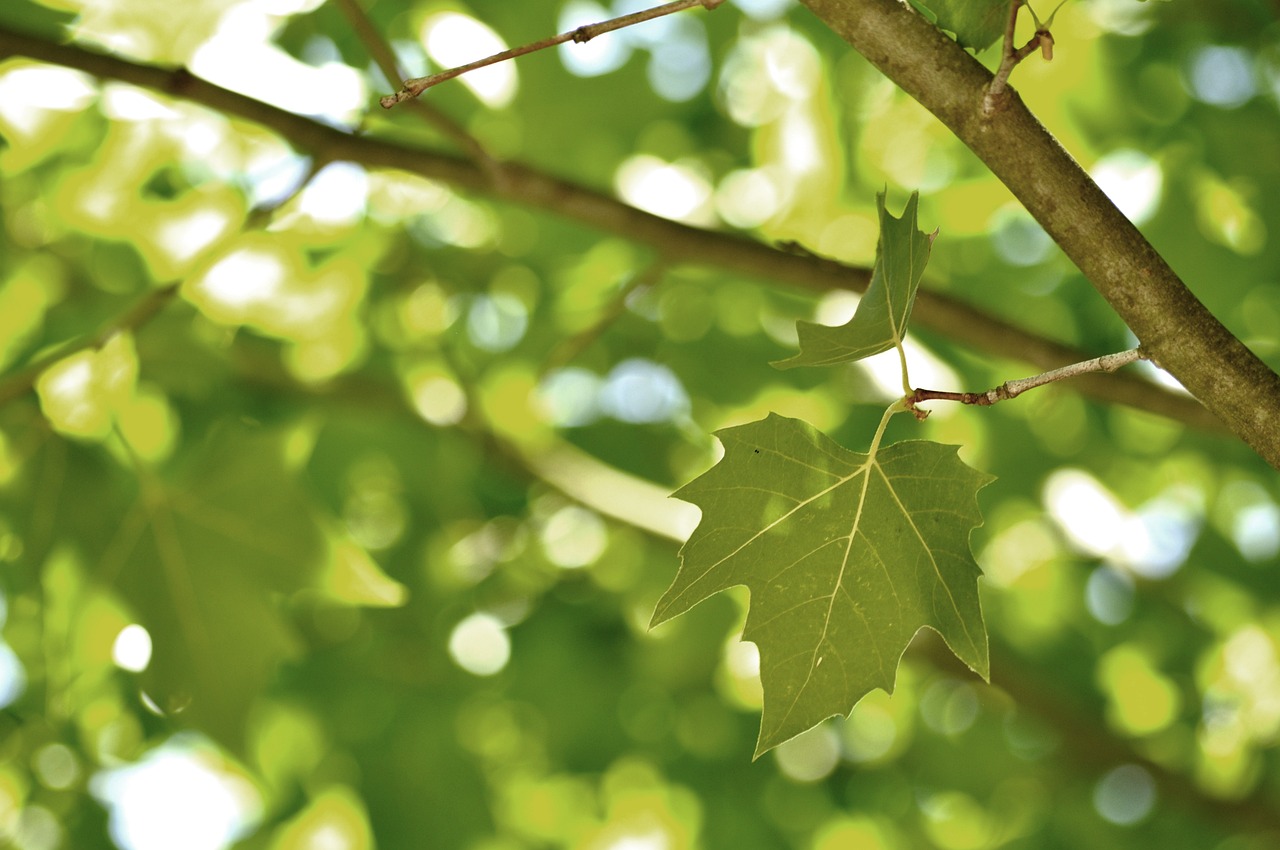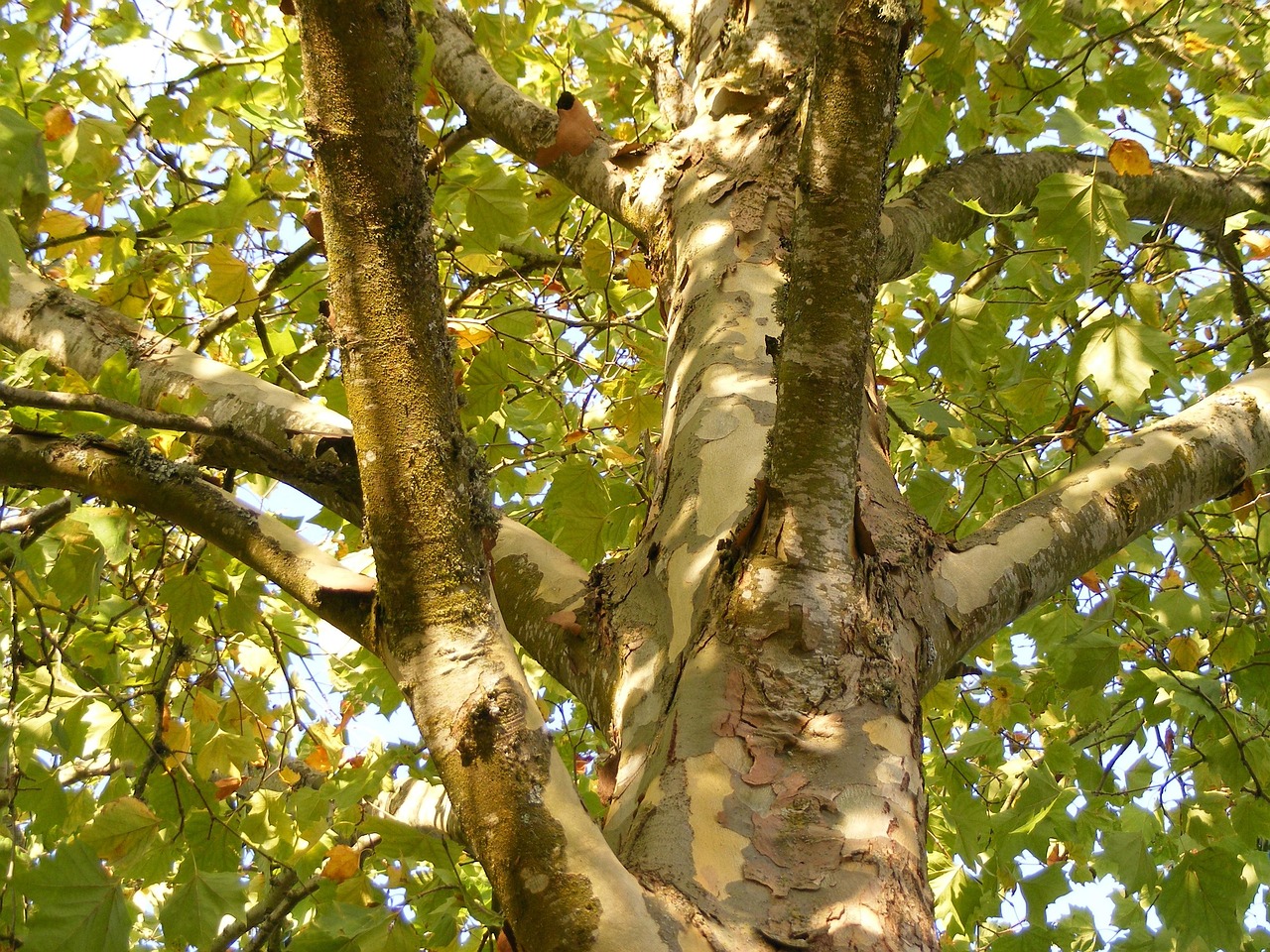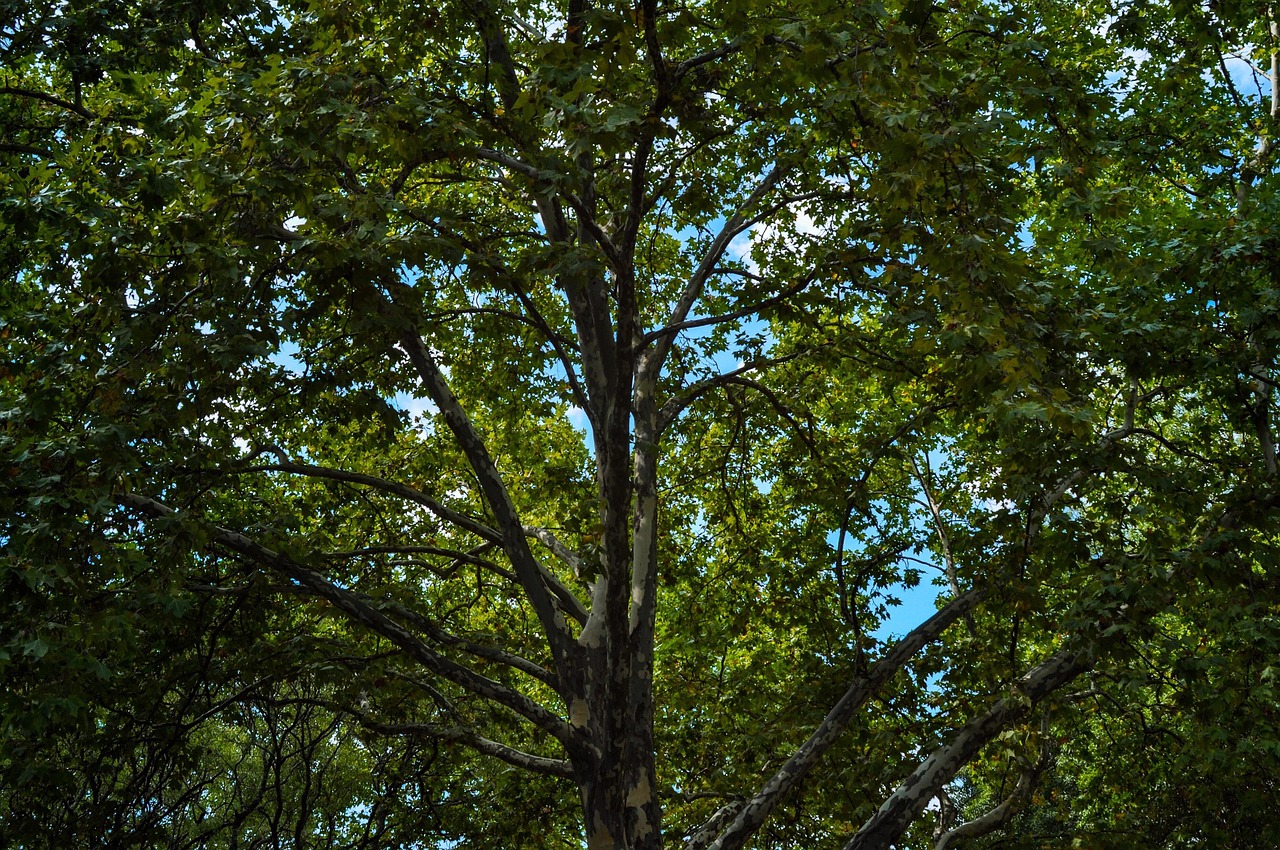The London Plane tree (Platanus × acerifolia) is known for its rapid growth rate and resilience in urban environments. It can grow up to 3 feet per year under optimal conditions, making it a popular choice for cities seeking to enhance their green spaces and improve air quality.
The London Plane tree is a hybrid species, resulting from the cross between the American sycamore and the Oriental plane. This tree has become a staple in urban landscapes, particularly in cities like London, due to its adaptability and strength. It is well-suited for various soil types and tolerates pollution, drought, and compacted soils. These characteristics make it an ideal candidate for urban forestry initiatives aimed at enhancing biodiversity and mitigating climate change effects.

One of the most significant advantages of the London Plane tree is its growth rate. This species can reach heights of 60 to 100 feet and can spread 40 to 80 feet wide. Its fast growth not only provides immediate aesthetic benefits but also contributes to environmental health by improving air quality. The large canopy offers shade, which helps reduce urban heat islands, thereby lowering energy consumption for cooling.
Growth Rate of the London Plane Tree
The growth rate of the London Plane tree can vary based on several factors, including soil quality, water availability, and environmental conditions. Typically, under ideal circumstances, these trees can achieve a height increase of 2 to 3 feet each year. This vigorous growth allows them to establish quickly in urban settings.
Here are some key factors that influence the growth rate of the London Plane tree:

- Soil Quality: Well-drained, nutrient-rich soil promotes faster growth.
- Water Availability: Consistent watering during dry periods enhances growth rates.
- Sunlight Exposure: Full sun conditions support optimal photosynthesis and growth.
- Competition: Trees planted in areas with less competition from other plants tend to grow faster.
Urban environments often present challenges for tree growth, such as compacted soil and limited root space. However, the London Plane tree’s robust root system allows it to thrive even when faced with these issues. Its ability to grow in less-than-ideal conditions makes it a resilient choice for city planners.
Urban Resilience and Sustainability
Urban resilience refers to the capacity of cities to absorb disturbances while maintaining essential functions. Trees like the London Plane contribute significantly to this resilience through various mechanisms.
Firstly, they help mitigate air pollution by absorbing carbon dioxide and filtering harmful pollutants from the air. This service is crucial in densely populated urban areas where air quality can be a significant concern. Moreover, the shade provided by their large leaves reduces the need for air conditioning in nearby buildings, contributing to energy savings.

Secondly, the London Plane tree plays a role in managing stormwater runoff. Its extensive root system helps retain water, reducing surface runoff during heavy rains. This ability to manage water is vital in preventing flooding and promoting groundwater recharge.
Benefits of the London Plane Tree in Urban Settings
The benefits of incorporating London Plane trees into urban environments extend beyond aesthetics. They provide numerous ecological, social, and economic advantages:
| Benefit | Description |
|---|---|
| Improved Air Quality | Absorbs carbon dioxide and filters air pollutants. |
| Urban Heat Reduction | Provides shade that lowers surrounding temperatures. |
| Stormwater Management | Helps reduce runoff and promotes water retention. |
| Biodiversity Support | Provides habitat for various urban wildlife species. |
| Aesthetic Value | Enhances the visual appeal of urban landscapes. |
The integration of London Plane trees into city planning not only supports urban resilience but also fosters a healthier living environment for residents. As cities continue to grow and face environmental challenges, planting these trees can be a vital step toward sustainable urban development.

Challenges Faced by London Plane Trees in Urban Environments
While the London Plane tree offers numerous benefits, it also faces several challenges in urban settings. Understanding these challenges is crucial for effective management and preservation of these trees. Here are some common issues they encounter:
- Soil Compaction: Urban development often leads to compacted soils, making it difficult for roots to grow and access nutrients.
- Pavement Damage: The expansive root systems of London Plane trees can lift and crack sidewalks and roadways, leading to maintenance issues.
- Pollution Stress: Although resilient, these trees can still suffer from high levels of air pollution, which may affect their health over time.
- Pests and Diseases: Urban areas may harbor pests that threaten tree health, including aphids and fungal infections.
To combat these challenges, city planners and arborists must implement strategies that promote healthy growth and longevity for the London Plane tree. This can include proper site selection, soil management, and regular health assessments.
Care and Maintenance of London Plane Trees
Proper care and maintenance are essential for maximizing the growth potential of London Plane trees. Here are some recommendations for ensuring their health in urban settings:
- Regular Watering: During dry spells, young trees should be watered deeply to encourage robust root development.
- Mulching: Applying mulch around the base can help retain moisture and reduce competition from weeds.
- Pruning: Regular pruning helps manage tree shape and removes dead or diseased branches.
- Soil Testing: Conducting soil tests can help identify nutrient deficiencies that may need addressing.
The importance of a proactive approach cannot be overstated. Regular assessments allow for early detection of potential issues related to pests or diseases, which can help mitigate more significant problems down the line.
Urban Planning and the Role of London Plane Trees
Incorporating London Plane trees into urban planning is not only beneficial but also essential for creating sustainable cities. Their presence enhances the urban ecosystem while providing social and economic benefits. Here are some considerations for urban planners:
- Green Infrastructure: Integrating trees into urban designs fosters green corridors that improve habitat connectivity.
- Community Spaces: Trees can enhance parks and recreational areas, making them more inviting places for residents.
- Climate Adaptation: Planting trees like the London Plane can help cities adapt to climate change by reducing heat and managing stormwater.
Furthermore, collaboration between city officials, landscape architects, and community members is vital. Engaging local communities in tree planting initiatives fosters a sense of ownership and responsibility towards urban greenery.
The Impact of Climate Change on London Plane Trees
As climate change continues to affect global weather patterns, the resilience of the London Plane tree will be tested. Understanding how climate change impacts this species is critical for future urban forestry strategies. Key factors to consider include:
- Temperature Variability: Increased average temperatures can affect the growth cycles and health of the trees.
- Altered Precipitation Patterns: Changes in rainfall can lead to drought stress or flooding, both of which can harm tree health.
- Pest Proliferation: Warmer temperatures may allow pests to thrive, increasing the risk of infestations.
To mitigate these risks, ongoing research is necessary to monitor the effects of climate change on urban trees. Adjusting planting strategies based on emerging data will be key to maintaining healthy populations of London Plane trees in cities.
The Future of London Plane Trees in Urban Landscapes
The future of London Plane trees in urban landscapes looks promising if proactive measures are taken. Their adaptability and resilience make them a cornerstone species for urban forestry. As cities continue to evolve, prioritizing these trees can enhance environmental quality and promote sustainable practices.
Innovation in urban design will also play a vital role in integrating green spaces into city infrastructure. This includes creating tree pits that accommodate root growth while minimizing damage to pavement. Collaborative efforts between governments, nonprofits, and citizens will be essential in ensuring that London Plane trees continue to thrive in our cities.
Community Engagement and Education
Engaging the community in tree planting and care initiatives is crucial for the success of London Plane trees in urban areas. By fostering a sense of responsibility and connection to local green spaces, residents can play an active role in maintaining the health of these trees. Education programs can help raise awareness about the importance of urban forestry and the specific benefits provided by London Plane trees.
Here are some effective strategies for community engagement:
- Workshops: Organizing workshops on tree care, identification, and environmental benefits can empower community members with knowledge.
- Volunteer Programs: Establishing volunteer days for planting and maintaining trees encourages community involvement and fosters a sense of ownership.
- School Programs: Integrating tree education into school curriculums can cultivate appreciation for nature in young students.
By involving the community, cities can ensure that London Plane trees are well-cared for and appreciated as vital components of the urban ecosystem.
The Role of Technology in Urban Forestry
Technology is playing an increasingly important role in urban forestry, including the management of London Plane trees. Innovations in data collection, monitoring, and analysis can enhance tree health and growth rates. Here are some ways technology is being utilized:
- Remote Sensing: Satellite imagery and drones can be used to monitor tree health, canopy cover, and growth patterns over time.
- Mobile Apps: Various applications allow citizens to report tree health issues or pests directly to local authorities, enabling quicker responses.
- Soil Sensors: These devices can provide real-time data on soil moisture levels, helping to optimize irrigation practices.
The integration of technology not only aids in the effective management of London Plane trees but also enhances public participation in urban forestry initiatives.
Case Studies: Successful Urban Forestry Initiatives
Several cities around the world have successfully integrated London Plane trees into their urban forestry programs. These case studies provide valuable insights into effective strategies and outcomes. Below are some notable examples:
| City | Initiative | Description |
|---|---|---|
| London, UK | Street Tree Care Program | A comprehensive initiative focusing on the maintenance and planting of street trees, including London Plane trees, to enhance urban greenery. |
| New York City, USA | MillionTreesNYC | A campaign aimed at planting one million trees throughout New York City, significantly increasing urban canopy cover. |
| Barcelona, Spain | Green Infrastructure Plan | This plan integrates green spaces with urban development, prioritizing tree planting along streets and parks. |
These initiatives demonstrate the positive impact of thoughtful urban forestry planning and highlight the potential for London Plane trees to contribute meaningfully to urban environments.
Benefits Beyond Aesthetics
The benefits of London Plane trees extend far beyond their aesthetic appeal. Their contributions to urban ecosystems are vital in addressing various environmental challenges faced by cities today. Some less obvious benefits include:
- Noise Reduction: The dense foliage of London Plane trees can help absorb sound, reducing noise pollution in busy urban areas.
- Carbon Sequestration: These trees actively absorb carbon dioxide from the atmosphere, playing a role in mitigating climate change effects.
- Heat Island Effect Mitigation: Trees help cool urban areas, lowering temperatures during hot summer months and reducing energy costs.
- Aesthetic Value Enhancement: Beyond beauty, the presence of trees can increase property values and attract tourism.
Recognizing these multifaceted benefits reinforces the importance of integrating London Plane trees into urban planning efforts. Cities that prioritize tree planting not only beautify their landscapes but also create healthier environments for their residents.
The Economic Impact of Urban Trees
The economic advantages of incorporating London Plane trees into urban settings are significant. Trees contribute to local economies in various ways, including:
- Increased Property Values: Properties with mature trees often command higher prices than those without.
- Tourism Attraction: Green spaces enhance a city’s appeal to tourists, contributing to local businesses.
- Energy Savings: The shade provided by trees can lead to lower cooling costs for residential and commercial buildings.
Cities that invest in urban forestry initiatives, such as planting and maintaining London Plane trees, are likely to see a return on investment through enhanced economic opportunities. By recognizing these benefits, urban planners can make informed decisions that positively impact both the environment and the economy.
Integrating London Plane Trees into Urban Planning
As cities continue to expand, the need for sustainable urban planning becomes increasingly critical. The integration of London Plane trees into urban landscapes not only enhances aesthetic appeal but also contributes to a wide range of environmental benefits, making them an essential component of urban forestry initiatives.
Urban planners should consider several strategies when incorporating London Plane trees into their designs:
- Strategic Placement: Planting trees in locations that maximize their benefits, such as along streets, in parks, and near buildings, can significantly improve air quality and reduce urban heat.
- Community Involvement: Engaging local residents in planting and caring for trees fosters a sense of ownership and responsibility, ensuring the long-term success of urban forestry programs.
- Long-Term Management Plans: Developing comprehensive management plans that address tree health, maintenance, and community education can sustain the benefits provided by London Plane trees.
By prioritizing these strategies, cities can create greener, more resilient environments that support the well-being of their residents.
Climate Adaptation and Mitigation Strategies
The challenges posed by climate change require innovative adaptation and mitigation strategies in urban settings. London Plane trees can play a crucial role in these efforts. Their resilience to varying environmental conditions makes them suitable candidates for enhancing urban ecosystems.
Some strategies cities can adopt include:
- Diverse Planting: While London Plane trees are valuable, diversifying tree species within urban areas can enhance resilience against pests and diseases.
- Monitoring and Research: Ongoing research into the growth patterns and health of London Plane trees will provide data to inform future urban forestry practices.
- Awareness Campaigns: Educating residents about the ecological benefits of trees can promote community involvement and support for urban forestry initiatives.
These strategies can help cities adapt to climate challenges while maintaining healthy green spaces that provide numerous benefits for urban dwellers.
The Role of Policy in Urban Forestry
Effective policy frameworks are paramount to supporting urban forestry initiatives. Policies that prioritize tree planting and maintenance can lead to significant improvements in urban resilience. Local governments should consider implementing policies that:
- Allocate Funding: Providing financial resources for tree planting and care can enhance the viability of urban forestry programs.
- Establish Tree Canopy Goals: Setting measurable goals for urban canopy cover can help track progress and ensure accountability.
- Encourage Public-Private Partnerships: Collaborating with local businesses and non-profit organizations can expand resources for tree care and community outreach.
Strong policies not only facilitate the growth and maintenance of London Plane trees but also foster a culture of sustainability within urban settings.
The Importance of Biodiversity
Biodiversity is essential for healthy ecosystems; thus, integrating a variety of tree species alongside London Plane trees is vital. Promoting biodiversity helps support a range of wildlife, improves ecosystem function, and enhances the overall resilience of urban areas.
Key benefits of maintaining biodiversity in urban forestry include:
- Pest Control: Diverse plantings can reduce the risk of widespread pest infestations that threaten single-species populations.
- Pollinator Support: A variety of flowering plants attracts pollinators, which are essential for the health of many urban ecosystems.
- Ecosystem Services: Different species provide a range of ecosystem services, including improved water quality and soil health.
By embracing biodiversity within urban forestry, cities can create more resilient and sustainable environments for both people and wildlife.
Final Thoughts
The London Plane tree exemplifies the potential benefits of integrating green infrastructure into urban environments. Its rapid growth rate, resilience to pollution, and ability to support biodiversity make it an invaluable asset in city landscapes. As communities strive to combat climate change, enhance air quality, and improve overall quality of life, prioritizing the planting and maintenance of London Plane trees becomes essential.
Through strategic planning, community engagement, and effective policy implementation, cities can maximize the ecological and economic benefits provided by these remarkable trees. By fostering a culture that values green spaces and invests in sustainable practices, we ensure healthier urban environments for current and future generations.
The future of urban landscapes lies in our ability to harmonize nature with development. The London Plane tree stands as a testament to this vision, embodying resilience and beauty in our ever-evolving cities.
